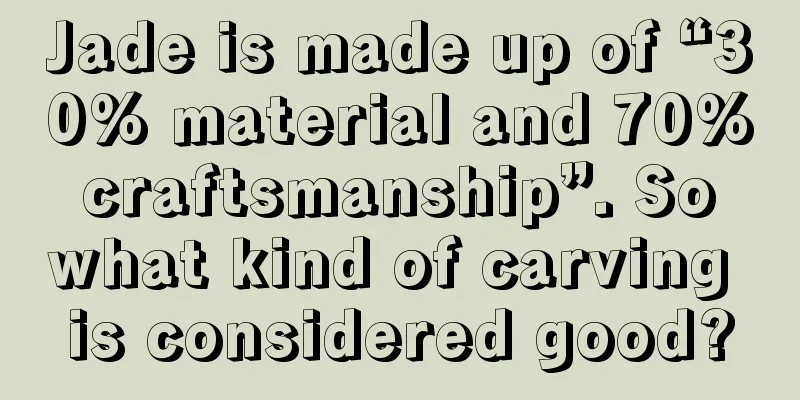Teach you how to identify jade "B" and "C" goods

|
When it comes to buying jade, the biggest concern of many jade lovers is buying fakes, which we in the industry call "B goods", "C goods" or "B+C goods". Although there are many different jade identification methods on the Internet, the editor believes that in order to learn to distinguish the real from the fake, we should first understand what "fake" jade is like! 1. Look at the color - whether there is a "color root"High-quality B-grade jadeite is generally brighter in color than A-grade jadeite after "bleaching" and dyeing, but it does not look natural and sometimes makes people feel it has a "yellowish" feel. It also has no "color roots", and the emerald color appears in flaky and band-like shapes and is blurred, with no changes in depth. Looking at the green part, when light propagates in natural A-grade jade, it will be obviously blocked by the boundaries or micro-cracks between the grains of jadeite, resulting in a color transition from dark to light and from presence to absence. The color roots of B-grade jadeite also want to imitate the diffusion shape of A-grade jadeite, but the color becomes floating. This is because the glue in the B-grade jadeite fills the cracks that block the color. Light can easily be transmitted between the jadeite particles and there is less reflection on the crack surface. 2. Look at the gloss - whether it has a "glass" glossNatural A-grade jade has a glassy luster, while B-grade jade has a "resinous" luster. After processing, it looks very transparent, sometimes more "A" than the A-grade products, and even has internal reflections (fluorescence), but the fluorescence of the two happens to be our identification standard! 3. Look at the structure - whether there are "fly wings"The internal structure of B-goods appears loose, and some crystals will be offset or displaced. A-grade jade has strong light penetrating power, is crystal clear, and has strong reflective power on the fly's wings; B-grade jade has weaker light penetrating power and is blurry; it feels like glass and silicone. 4. Look at the epidermis - whether there is "orange peel"If the internal structure may be abstract, then let’s just look at the surface! All B-goods are introduced from the surface, so they will definitely leave clues on the surface. The surface of B-grade jade has "acid-etched spider web patterns" and "pits", which are different from the orange peel texture of natural A-grade jade. When observing B-grade goods under a 20x microscope, you can usually see this spider web structure and shiny objects, which means it is basically a B-grade product. Nowadays, "fake technology" is emerging in an endless stream, and it is difficult to distinguish with the naked eye. It can only be helped by tools such as handheld magnifying glasses. 5. Check the certificate - the most reliable identificationA jewelry appraisal certificate is like a person’s ID card, its importance is self-evident. The certificate issued after the B-grade jade is identified is jadeite (processed). So, how do you read the certificate of genuine jadeite? fcgc66 fcpf18 |
<<: How to identify "B-grade" jade products
>>: Common dragon patterns and their meanings in jade carvings
Recommend
To make a fine jade product, the most important process is polishing. How to polish a jade product?
Man takes care of jade for three years, and jade ...
"Type, water, color and workmanship" are the basis for selecting jadeite, and the new trend of collection and purchase also needs to consider these four points
Good quality and water can bring out the color of...
What does it mean when jadeite fluoresces? Correctly understand the lustre phenomenon of jadeite!
When buying jewelry, we often encounter this prob...
What do women talk about when they talk about jewelry and jade?
Women love to discuss jewelry, such as “how much ...
Symbiotic minerals of jadeite
Jade has variant symbiotic organisms, which is a ...
Jade, the one and only me, flawed but beautiful!
I am a piece of jade, formed by unique geological...
The fusion of jadeite and gold and silver metals brings another kind of beauty
For Chinese people, jade is both a high-end luxur...
Green jade is too expensive and violet makes you look old? In fact, the most versatile and inexpensive jade is this
Nowadays, jade is becoming more and more well-kno...
Is there anything I should pay attention to when wearing jade on my body?
Now that people's lives are better, many peop...
Jade carving, highly difficult intaglio carving technique!
China is a vast country with rich resources. Ther...
How to choose jadeite to get high cost performance
How to match jadeite? How to choose good jadeite?...
Don’t know how to choose jade carving? Just look at these three points.
Everyone loves exquisite jade, especially carving...
When choosing a Buddha, don’t be too Buddhist! You have to have such standards
Is your shopping method and standard Buddhist? &q...
Who has better jade carving skills?
Jade carving integrates the expressive techniques...
Appreciate the exquisite carvings, the perfect combination of "color" and "art"!
Polishing a rough jade will reveal a beautiful ja...









